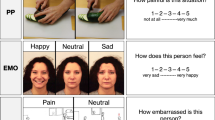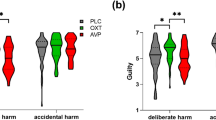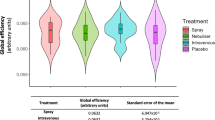Abstract
Receiving negative social feedback can be detrimental to emotional, cognitive, and physical well-being, and fear of negative social feedback is a prominent feature of mental illnesses that involve social anxiety. A large body of evidence has implicated the neuropeptides oxytocin and vasopressin in the modulation of human neural activity underlying social cognition, including negative emotion processing; however, the influence of oxytocin and vasopressin on neural activity elicited during negative social evaluation remains unknown. Here 21 healthy men underwent functional magnetic resonance imaging in a double-blind, placebo-controlled, crossover design to determine how intranasally administered oxytocin and vasopressin modulated neural activity when receiving negative feedback on task performance from a study investigator. We found that under placebo, a preferential response to negative social feedback compared with positive social feedback was evoked in brain regions putatively involved in theory of mind (temporoparietal junction), pain processing (anterior insula and supplementary motor area), and identification of emotionally important visual cues in social perception (right fusiform). These activations weakened with oxytocin and vasopressin administration such that neural responses to receiving negative social feedback were not significantly greater than positive social feedback. Our results show effects of both oxytocin and vasopressin on the brain network involved in negative social feedback, informing the possible use of a pharmacological approach targeting these regions in multiple disorders with impairments in social information processing.
Similar content being viewed by others
Log in or create a free account to read this content
Gain free access to this article, as well as selected content from this journal and more on nature.com
or
References
Akinola M, Mendes WB (2008). The dark side of creativity: biological vulnerability and negative emotions lead to greater artistic creativity. Pers Soc Psychol Bull 34: 1677–1686.
Bahnemann M, Dziobek I, Prehn K, Wolf I, Heekeren HR (2010). Sociotopy in the temporoparietal cortex: common versus distinct processes. Soc Cogn Affect Neurosci 5: 48–58.
Baumeister RF, Bratslavsky E, Finkenauer C, Vohs KD (2001). Bad is stronger than good. Rev Gen Psychol 5: 323–370.
Behrens TE, Hunt LT, Woolrich MW, Rushworth MF (2008). Associative learning of social value. Nature 456: 245–249.
Born J, Lange T, Kern W, McGregor GP, Bickel U, Fehm HL (2002). Sniffing neuropeptides: a transnasal approach to the human brain. Nat Neurosci 5: 514–516.
Bradley MM, Lang PJ (1994). Measuring emotion: the self-assessment manikin and the semantic differential. J Behav Ther Exp Psychiatry 25: 49–59.
Brunnlieb C, Munte TF, Tempelmann C, Heldmann M (2013). Vasopressin modulates neural responses related to emotional stimuli in the right amygdala. Brain Res 1499: 29–42.
Carrington SJ, Bailey AJ (2009). Are there theory of mind regions in the brain? A review of the neuroimaging literature. Hum Brain Mapp 30: 2313–2335.
Chen X, Hackett PD, DeMarco AC, Feng C, Stair S, Haroon E et al (2016). Effects of oxytocin and vasopressin on the neural response to unreciprocated cooperation within brain regions involved in stress and anxiety in men and women. Brain Imaging Behav 10: 581–593.
Cooper JC, Dunne S, Furey T, O'Doherty JP (2014). The role of the posterior temporal and medial prefrontal cortices in mediating learning from romantic interest and rejection. Cereb Cortex 24: 2502–2511.
Craggs JG, Price DD, Verne GN, Perlstein WM, Robinson MM (2007). Functional brain interactions that serve cognitive-affective processing during pain and placebo analgesia. Neuroimage 38: 720–729.
Cristofori I, Moretti L, Harquel S, Posada A, Deiana G, Isnard J et al (2013). Theta signal as the neural signature of social exclusion. Cereb Cortex 23: 2437–2447.
Dickerson SS, Gruenewald TL, Kemeny ME (2004a). When the social self is threatened: shame, physiology, and health. J Pers 72: 1191–1216.
Dickerson SS, Kemeny ME (2004b). Acute stressors and cortisol responses: a theoretical integration and synthesis of laboratory research. Psychol Bull 130: 355–391.
Domes G, Heinrichs M, Glascher J, Buchel C, Braus DF, Herpertz SC (2007). Oxytocin attenuates amygdala responses to emotional faces regardless of valence. Biol Psychiatry 62: 1187–1190.
Domes G, Lischke A, Berger C, Grossmann A, Hauenstein K, Heinrichs M et al (2010). Effects of intranasal oxytocin on emotional face processing in women. Psychoneuroendocrinology 35: 83–93.
Ebstein RP, Israel S, Lerer E, Uzefovsky F, Shalev I, Gritsenko I et al (2009). Arginine vasopressin and oxytocin modulate human social behavior. Ann NY Acad Sci 1167: 87–102.
Eisenberger NI (2012). The pain of social disconnection: examining the shared neural underpinnings of physical and social pain. Nat Rev Neurosci 13: 421–434.
Eisenberger NI, Lieberman MD, Williams KD (2003). Does rejection hurt? An FMRI study of social exclusion. Science 302: 290–292.
Etkin A, Egner T, Kalisch R (2011). Emotional processing in anterior cingulate and medial prefrontal cortex. Trends Cognit Sci 15: 85–93.
Evans S, Shergill SS, Averbeck BB (2010). Oxytocin decreases aversion to angry faces in an associative learning task. Neuropsychopharmacology 35: 2502–2509.
Feng C, Hackett PD, DeMarco AC, Chen X, Stair S, Haroon E et al (2015a). Oxytocin and vasopressin effects on the neural response to social cooperation are modulated by sex in humans. Brain Imaging Behav 9: 754–764.
Feng C, Lori A, Waldman ID, Binder EB, Haroon E, Rilling JK (2015b). A common oxytocin receptor gene (OXTR) polymorphism modulates intranasal oxytocin effects on the neural response to social cooperation in humans. Genes Brain Behav 14: 516–525.
Gamer M, Zurowski B, Buchel C (2010). Different amygdala subregions mediate valence-related and attentional effects of oxytocin in humans. Proc Natl Acad Sci USA 107: 9400–9405.
Groppe SE, Gossen A, Rademacher L, Hahn A, Westphal L, Grunder G et al (2013). Oxytocin influences processing of socially relevant cues in the ventral tegmental area of the human brain. Biol Psychiatry 74: 172–179.
Gundel H, O'Connor MF, Littrell L, Fort C, Lane RD (2003). Functional neuroanatomy of grief: an FMRI study. Am J Psychiatry 160: 1946–1953.
Haxby JV, Gobbini MI, Furey ML, Ishai A, Schouten JL, Pietrini P (2001). Distributed and overlapping representations of faces and objects in ventral temporal cortex. Science 293: 2425–2430.
Heinrichs M, Baumgartner T, Kirschbaum C, Ehlert U (2003). Social support and oxytocin interact to suppress cortisol and subjective responses to psychosocial stress. Biol Psychiatry 54: 1389–1398.
Heinrichs M, von Dawans B, Domes G (2009). Oxytocin, vasopressin, and human social behavior. Front Neuroendocrinol 30: 548–557.
Kanat M, Heinrichs M, Schwarzwald R, Domes G (2015). Oxytocin attenuates neural reactivity to masked threat cues from the eyes. Neuropsychopharmacology 40: 287–295.
Kinoshita Y, Kingdon D, Kinoshita K, Kinoshita Y, Saka K, Arisue Y et al (2011). Fear of negative evaluation is associated with delusional ideation in non-clinical population and patients with schizophrenia. Soc Psychiatry Psychiatric Epidemiol 46: 703–710.
Kirsch P, Esslinger C, Chen Q, Mier D, Lis S, Siddhanti S et al (2005). Oxytocin modulates neural circuitry for social cognition and fear in humans. J Neurosci 25: 11489–11493.
Kis A, Kemerle K, Hernadi A, Topal J (2013). Oxytocin and social pretreatment have similar effects on processing of negative emotional faces in healthy adult males. Front Psychol 4: 532.
Knutson B, Fong GW, Adams CM, Varner JL, Hommer D (2001). Dissociation of reward anticipation and outcome with event-related fMRI. Neuroreport 12: 3683–3687.
Kosfeld M, Heinrichs M, Zak PJ, Fischbacher U, Fehr E (2005). Oxytocin increases trust in humans. Nature 435: 673–676.
Kret ME, Pichon S, Grezes J, de Gelder B (2011). Similarities and differences in perceiving threat from dynamic faces and bodies. An fMRI study. Neuroimage 54: 1755–1762.
Labuschagne I, Phan KL, Wood A, Angstadt M, Chua P, Heinrichs M et al (2010). Oxytocin attenuates amygdala reactivity to fear in generalized social anxiety disorder. Neuropsychopharmacology 35: 2403–2413.
Lamm C, Decety J, Singer T (2011). Meta-analytic evidence for common and distinct neural networks associated with directly experienced pain and empathy for pain. Neuroimage 54: 2492–2502.
Ma Y, Li S, Wang C, Liu Y, Li W, Yan X et al (2016). Distinct oxytocin effects on belief updating in response to desirable and undesirable feedback. Proc Natl Acad Sci USA 113: 9256–9261.
Mendes WB, Major B, McCoy S, Blascovich J (2008). How attributional ambiguity shapes physiological and emotional responses to social rejection and acceptance. J Pers Soc Psychol 94: 278–291.
Meyer JA, Mundy PC, Van Hecke AV, Durocher JS (2006). Social attribution processes and comorbid psychiatric symptoms in children with Asperger syndrome. Autism 10: 383–402.
Norman GJ, Cacioppo JT, Morris JS, Karelina K, Malarkey WB, Devries AC et al (2011). Selective influences of oxytocin on the evaluative processing of social stimuli. J Psychopharmacol 25: 1313–1319.
O'Connor LE, Berry JW, Weiss J, Gilbert P (2002). Guilt, fear, submission, and empathy in depression. J Affective Disord 71: 19–27.
Pera-Guardiola V, Contreras-Rodriguez O, Batalla I, Kosson D, Menchon JM, Pifarre J et al (2016). Brain structural correlates of emotion recognition in psychopaths. PloS ONE 11: e0149807.
Petrovic P, Kalisch R, Singer T, Dolan RJ (2008). Oxytocin attenuates affective evaluations of conditioned faces and amygdala activity. J Neurosci 28: 6607–6615.
Peyron R, Laurent B, Garcia-Larrea L (2000). Functional imaging of brain responses to pain. A review and meta-analysis (2000). Neurophysiol Clin 30: 263–288.
Prochnow D, Hoing B, Kleiser R, Lindenberg R, Wittsack HJ, Schafer R et al (2013). The neural correlates of affect reading: an fMRI study on faces and gestures. Behav Brain Res 237: 270–277.
Rapee RM, Heimberg RG (1997). A cognitive-behavioral model of anxiety in social phobia. Behav Res Ther 35: 741–756.
Rilling JK, DeMarco AC, Hackett PD, Thompson R, Ditzen B, Patel R et al (2012). Effects of intranasal oxytocin and vasopressin on cooperative behavior and associated brain activity in men. Psychoneuroendocrinology 37: 447–461.
Saxe R, Kanwisher N (2003). People thinking about thinking people. The role of the temporo-parietal junction in ‘theory of mind’. Neuroimage 19: 1835–1842.
Shamay-Tsoory SG (2011). The neural bases for empathy. Neuroscientist 17: 18–24.
Shin NY, Park HY, Jung WH, Park JW, Yun JY, Jang JH et al (2015). Effects of oxytocin on neural response to facial expressions in patients with schizophrenia. Neuropsychopharmacology 40: 1919–1927.
Spielberger CD (1988) Manual for the State-Trait Anger Expression Inventory (STAXI). Psychological Assessment Resources: Odessa, FL, USA.
Spielberger CD, Gorsuch RL, Lushene PR, Vagg PR, Jacobs AG (1983) Manual for the State-Trait Anxiety Inventory (Form Y). Consulting Psychologists Press: Palo Alto, CA.
Striepens N, Scheele D, Kendrick KM, Becker B, Schafer L, Schwalba K et al (2012). Oxytocin facilitates protective responses to aversive social stimuli in males. Proc Natl Acad Sci USA 109: 18144–18149.
Theodoridou A, Rowe AC, Penton-Voak IS, Rogers PJ (2009). Oxytocin and social perception: oxytocin increases perceived facial trustworthiness and attractiveness. Horm Behav 56: 128–132.
Thompson R, Gupta S, Miller K, Mills S, Orr S (2004). The effects of vasopressin on human facial responses related to social communication. Psychoneuroendocrinology 29: 35–48.
Thompson RR, George K, Walton JC, Orr SP, Benson J (2006). Sex-specific influences of vasopressin on human social communication. Proc Natl Acad Sci USA 103: 7889–7894.
Treede RD, Kenshalo DR, Gracely RH, Jones AK (1999). The cortical representation of pain. Pain 79: 105–111.
Tusche A, Bockler A, Kanske P, Trautwein FM, Singer T (2016). Decoding the charitable brain: empathy, perspective taking, and attention shifts differentially predict altruistic giving. The J Neurosci 36: 4719–4732.
Van Overwalle F (2009). Social cognition and the brain: a meta-analysis. Hum Brain Mapp 30: 829–858.
Wang WT, Hsu WY, Chiu YC, Liang CW (2012). The hierarchical model of social interaction anxiety and depression: the critical roles of fears of evaluation. J Anxiety Disord 26: 215–224.
Watson D, Clark LA, Tellegen A (1988). Development and validation of brief measures of positive and negative affect: the PANAS scales. J Pers Soc Psychol 54: 1063–1070.
Wittfoth-Schardt D, Grunding J, Wittfoth M, Lanfermann H, Heinrichs M, Domes G et al (2012). Oxytocin modulates neural reactivity to children's faces as a function of social salience. Neuropsychopharmacology 37: 1799–1807.
Young L, Camprodon JA, Hauser M, Pascual-Leone A, Saxe R (2010). Disruption of the right temporoparietal junction with transcranial magnetic stimulation reduces the role of beliefs in moral judgments. Proc Natl Acad Sci USA 107: 6753–6758.
Young L, Saxe R (2008). The neural basis of belief encoding and integration in moral judgment. Neuroimage 40: 1912–1920.
Zink CF, Kempf L, Hakimi S, Rainey CA, Stein JL, Meyer-Lindenberg A (2011). Vasopressin modulates social recognition-related activity in the left temporoparietal junction in humans. Transl Psychiatry 1: e3.
Zink CF, Stein JL, Kempf L, Hakimi S, Meyer-Lindenberg A (2010). Vasopressin modulates medial prefrontal cortex-amygdala circuitry during emotion processing in humans. J Neurosci 30: 7017–7022.
Acknowledgements
We thank all physicians and nurses who helped us conducting this research, Gerald Overman and Judith Starling for pharmaceutical management, Lainey Bukowiec for manuscript and figure assistance, and Elizabeth Smith for thoughtful comments on the manuscript. We also thank all individuals who participated in our study.
Author information
Authors and Affiliations
Corresponding author
Additional information
Supplementary Information accompanies the paper on the Neuropsychopharmacology website
Supplementary information
Rights and permissions
About this article
Cite this article
Gozzi, M., Dashow, E., Thurm, A. et al. Effects of Oxytocin and Vasopressin on Preferential Brain Responses to Negative Social Feedback. Neuropsychopharmacol 42, 1409–1419 (2017). https://doi.org/10.1038/npp.2016.248
Received:
Revised:
Accepted:
Published:
Issue date:
DOI: https://doi.org/10.1038/npp.2016.248
This article is cited by
-
Different Types of Social Feedback can Enhance or Reduce Performance, and Induce or Alleviate Psychosocial Stress: An Exploratory Study of the Underlying Neurophysiological Mechanisms
Adaptive Human Behavior and Physiology (2025)
-
Oxytocin, but not vasopressin, decreases willingness to harm others by promoting moral emotions of guilt and shame
Molecular Psychiatry (2024)
-
Effects of arginine vasopressin on human anxiety and associations with sex, dose, and V1a-receptor genotype
Psychopharmacology (2024)
-
The neurocognitive impact of loneliness and social networks on social adaptation
Scientific Reports (2023)
-
Vasopressin enhances human preemptive strike in both males and females
Scientific Reports (2019)



